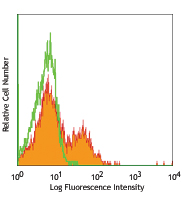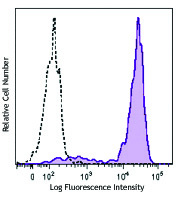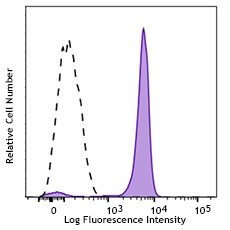- Regulatory Status
- RUO
- Other Names
- OPG, APRIL (TNFSF13), TRAIL (TNFSF10), sCD40L (TNFSF5), TWEAK (TNFSF12), LIGHT (TNFSF14), FasL (TNFSF6), RANKL (TNFSF11), TNF-α (TNFSF2),TNF-β (TNFSF1), BAFF (TNFSF20), CD30L (TNFSF8)
- Ave. Rating
- Submit a Review
- Product Citations
- publications
TNFSF ligands and receptors work together and play pivotal roles in the modulation of cellular functions. They are essential for many developmental, homeostatic and stimulus-responsive processes. They are also involved in cellular differentiation, survival, programmed death, and more importantly, the immune response. TNFSF ligands are linked to many human diseases, especially chronic inflammatory diseases, autoimmune diseases, and cancer.
The LEGENDplex™ Human TNFSF Family Panel 1 is a bead-based multiplex assay, using fluorescence-encoded beads suitable for use on various flow cytometers. This panel allows simultaneous quantification of 12 human TNFSF family ligands: OPG, APRIL (TNFSF13), TRAIL (TNFSF10), sCD40L (TNFSF5), TWEAK (TNFSF12), LIGHT (TNFSF14), FasL (TNFSF6), RANKL (TNFSF11), TNF-a (TNFSF2), TNF-b (TNFSF1), BAFF (TNFSF20), CD30L (TNFSF8). This panel provides higher sensitivity and broader dynamic range than the traditional ELISA method. The panel has been validated for use on serum and cell culture supernatant samples.
A LEGENDplex™ Mix and Match system is available to customize assays for specificities within this TNFSF Family panel.
Kit Contents
- Kit Contents
-
- Setup Beads: PE Beads
- Setup Beads: Raw Beads
- LEGENDplex™ Human TNFSF Family Panel 1 Premixed Beads
- LEGENDplex™ Human TNFSF Family Panel 1 Detection Antibodies
- LEGENDplex™ Human TNFSF Family Panel 1 Standard
- LEGENDplex™ Matrix A, Lyophilized
- LEGENDplex™ SA-PE
- LEGENDplex™ Assay Buffer
- LEGENDplex™ Wash Buffer, 20X
- Plate Sealers
- V-bottom Plate
Product Details
- Verified Reactivity
- Human
- Application
-
Multiplex
Learn more about LEGENDplex™ at biolegend.com/legendplex
Download the LEGENDplex™ software here. - Materials Not Included
-
- Flow Cytometer
- Pipettes and Tips
- Reagent Reservoirs for Multichannel Pipettes
- Polypropylene Microfuge Tubes
- Vortex Mixer
- Sonicator
- Aluminum Foil
- Absorbent Pads or Paper Towels
- Plate Shaker
- Tabletop Centrifuges
- A Vacuum Filtration Unit and a Vacuum Source (if using filter plates)
- Centrifuge with a swinging bucket adaptor for microtiter plates (if using V-bottom plates)
- 1.1 mL polypropylene micro FACS tubes, in 96-tube rack
- Manual
Antigen Details
- Molecular Family
- Cytokines/Chemokines
- Gene ID
- 4982 View all products for this Gene ID 8741 View all products for this Gene ID 8743 View all products for this Gene ID 959 View all products for this Gene ID 8742 View all products for this Gene ID 8740 View all products for this Gene ID 356 View all products for this Gene ID 8600 View all products for this Gene ID 7124 View all products for this Gene ID 4049 View all products for this Gene ID 10673 View all products for this Gene ID 944 View all products for this Gene ID
Related Pages & Pathways
Pages
Related FAQs
- If I don't have a vacuum, how do I remove the liquid from my plate?
-
If you do not have a vacuum, the assay should be run in a V-bottom plate. After centrifugation using a swinging-bucket rotor with a plate adaptor, you can remove the liquid by flicking the plate quickly, dumping the contents into a sink, and patting it dry carefully on a stack of clean paper towels without losing the beads. Alternatively, you can remove the liquid by using a pipette.
- Should I perform the assay with the filter plates or with V-bottom plates?
-
Filter plates or V-bottom plates have been included in some kits for your convenience. A vacuum filtration unit is required to work with the filter plates. However, if you don’t have access to a vacuum manifold or if you prefer, then you can use the V-bottom plates and follow the recommended assay protocols for the type of plates you choose. All plates should be made from low binding polypropylene. Polystyrene ELISA or cell culture plates should not be used.
- After I finish the staining process, how long can I wait before reading my LEGENDplex™ samples?
-
The samples can be kept overnight at 4°C while being protected from exposure to light and be read the next day. There may be a decrease in signal, but overall, the assay results should not be affected. Storing the samples for extended periods of time is not recommended, as it could lead to further reductions in signal.
- What is the shelf life of LEGENDplex™ kits?
-
LEGENDplex™ kits are guaranteed for 6 months from the date of receipt, but may have a shelf life of up to 2 years from the date of manufacture.
- Is special software required for data analysis?
-
Typically flow cytometers generate output files in FCS format (e.g. FCS 2.0, 3.0, or 3.1) and in some cases in list mode file format (LMD). Other software may be available to analyze FCS files. Data generated using LEGENDplex™ kits can be analyzed using the freely available LEGENDplex™ data analysis software. Please check our website for the most updated versions of the software.












Follow Us